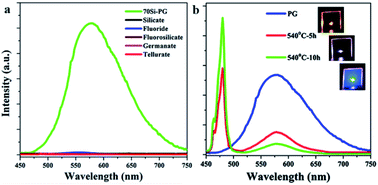Modulation of activator distribution by phase-separation of glass for efficient and tunable upconversion luminescence
Abstract
Amorphous glass is a significant luminescence matrix for various applications, such as fiber lasers, lighting and 3D data storage. However, the efficiency of luminescence, especially upconversion (UC) luminescence, in glass is usually low. The UC emission of transition metal ions is hardly observed in amorphous glass. Here, a strategy is proposed to modulate the distribution of activators based on phase-separated glass for achieving high-efficiency UC luminescence. It is demonstrated that high-efficiency UC luminescence of Yb3+–Yb3+ pairs and Mn2+–Yb3+ dimers are observed in the amorphous glass due to the excellent confinement of phase-separated networks to activators. The UC emission intensity of the phase-separated glass is even higher than that of all-fluoride glass. Furthermore, KZnF3 and KYb3F10 crystals are controllably precipitated from the glass matrix regulated by phase-separated networks. This perfectly confines activators in crystal environments, greatly enhances the UC luminescence and controllably tailors the luminescence color. This glass possesses large potential for promising application in tunable fiber lasers, multicolor displays and multiphoton excitation-based 3D optical data storage. Most importantly, the modulation strategy based on phase-separated networks paves a new way for manufacturing a wide range of optical gain materials featuring efficient and wavelength-tunable luminescence.



 Please wait while we load your content...
Please wait while we load your content...